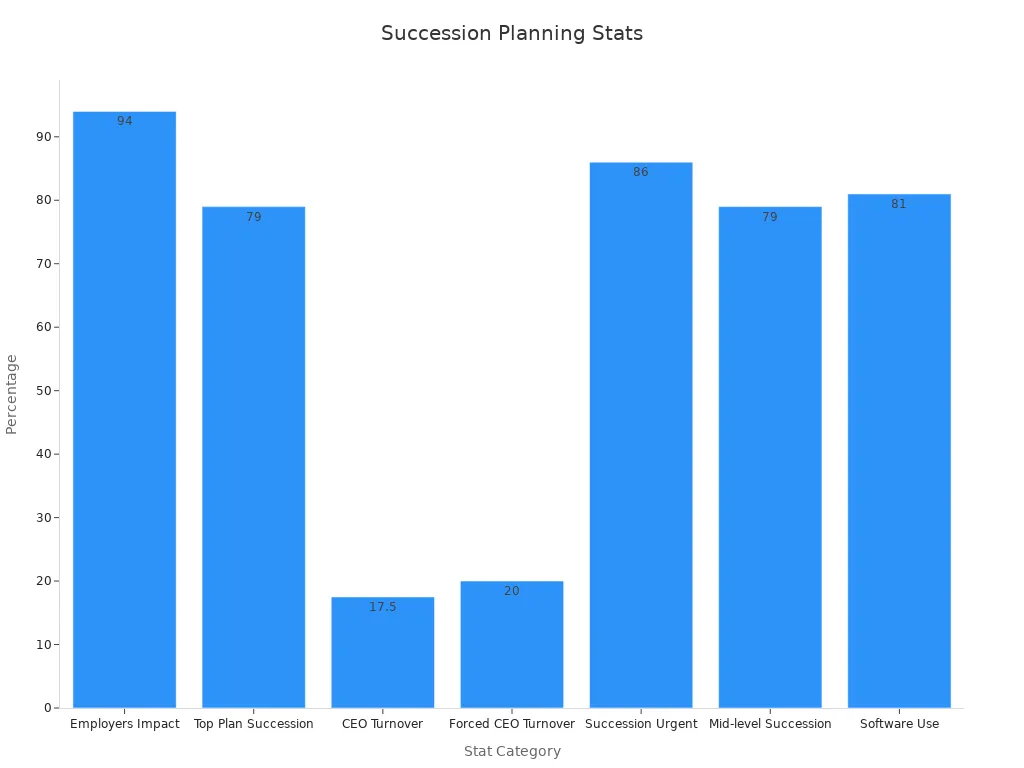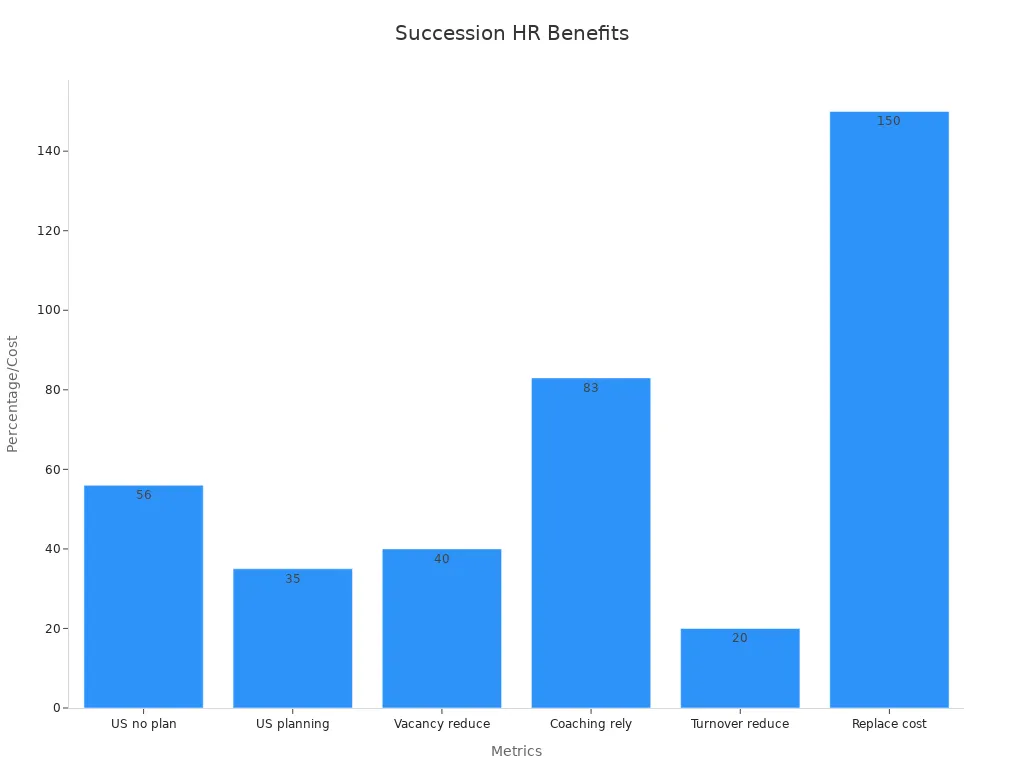Everything You Need to Know About Succession Planning

Succession planning prepares organizations to fill key roles and maintain stability when changes occur. This process benefits clients, leaders, and teams by ensuring business continuity and growth. Recent data shows 86% of leaders recognize its value, but only 14% feel confident in execution. Companies with effective succession planning see up to 30% better performance and 67% lower turnover. Systems and teams that follow clear optimization steps identify future leaders, improve engagement, and achieve stronger results.
Key Takeaways
Succession planning helps organizations prepare for leadership changes to keep business running smoothly.
Effective succession plans improve company performance, reduce employee turnover, and save money on hiring costs.
Key steps include identifying critical roles, defining needed skills, assessing talent, and developing future leaders.
Strong leadership pipelines come from ongoing training, mentoring, and clear communication about growth opportunities.
Aligning succession planning with company goals ensures leaders are ready to support long-term success.
Using data and assessment tools helps find the best candidates fairly and supports diversity in leadership.
Common mistakes like ignoring important roles, poor communication, and outdated plans can harm succession efforts.
Leadership commitment and integration with HR practices are essential to build and maintain a strong talent pipeline.
What Is Succession Planning

Definition
Succession planning is a structured process that prepares organizations to fill important roles when changes happen. This process helps companies identify and develop employees who can step into leadership or other critical positions. Systems and teams use succession planning to make sure they always have skilled people ready to lead. This approach supports business continuity and reduces the risk of disruption when someone leaves a key role.
Purpose
The main purpose of succession planning is to keep organizations stable and agile during leadership changes. Companies that plan for the future avoid losing momentum if a leader leaves suddenly. Succession planning also protects profitability and helps teams adapt to new challenges. In large corporations, boards and CEOs oversee formal plans to train mid-level employees for higher positions. Small businesses often focus on preparing the next generation, with owners guiding the process. The table below shows how succession planning looks different in large and small organizations:
Aspect | Large Corporations | Small Businesses / Family-Owned Companies |
|---|---|---|
Governance | Board of directors and CEO | Owner usually responsible |
Succession Focus | Training mid-level employees for higher positions | Training the next generation |
Impacted Stakeholders | Employees and shareholders | Employees and family members |
Succession Plan Types | Emergency and long-term plans | Often informal or owner-driven plans |
Succession planning also encourages leaders to think ahead and prepare for change. This mindset helps organizations stay resilient and ready for the future.
Key Elements
Effective succession planning includes several key elements that support long-term success:
Identifying critical roles that impact business operations.
Assessing current talent to find employees with leadership potential.
Developing successors through coaching, mentoring, and training.
Using data and metrics to measure progress and readiness.
Aligning talent development with strategic goals.
Companies with strong succession planning see better business continuity and fewer disruptions during leadership transitions. They also improve employee engagement and retention by showing a commitment to professional growth. Systems and teams that use clear processes for talent reviews and development build a sustainable leadership pipeline.
Organizations track their succession planning efforts with quantitative measures such as:
Internal promotion rates for key roles
Time-to-fill for critical positions
Employee engagement survey scores
Retention rates of high-potential employees
Diversity among succession candidates
Readiness assessments for successors
Research shows that companies using data-driven approaches, like predictive analytics and performance scores, increase leadership readiness by up to 30%. These practices help systems and teams achieve stronger results and prepare for future challenges. For more information on how to build or improve a succession plan, clients can reach out to learn about proven strategies and tools.
Why It Matters
Benefits
Organizations that prepare for leadership changes see measurable improvements in stability and performance. Systems and teams that invest in future leaders experience higher employee engagement and lower turnover. Research shows that 94% of employers report a positive impact on engagement when they have a clear plan for leadership transitions. More than half of employees say they feel more engaged if their company has a plan in place. Younger workers, especially those aged 18 to 34, report over 90% improved engagement when they see clear opportunities for advancement.
Tip: Systems and teams that communicate their plans for leadership development build trust and confidence among employees.
The following table highlights the financial and retention benefits:
Benefit Aspect | Numerical Evidence | Explanation |
|---|---|---|
Cost Savings from Internal Promotion | $75,000 saved on recruiting fees by promoting internally instead of external hiring | Avoids expensive recruiting fees and operational disruptions when filling key roles internally. |
Financial Impact of Turnover Costs | $112 billion cost associated with lack of succession planning in public companies | Represents hard costs like executive searches, severance, and lost revenue due to turnover. |
Employee Value on Learning Opportunities | 91% of workers value consistent learning opportunities | Succession planning supports ongoing professional development, which increases retention. |

Systems and teams that use structured approaches also outperform their peers. Top-performing companies report planned successions 79% of the time. These organizations see 2.2 times higher revenue growth and 1.5 times greater profitability. Clients who focus on developing internal talent save money and avoid the disruption of external hires.
Risks
Without a formal plan, organizations face serious risks. Only 35% to 44% of companies have a formal process, while more than half operate without one. This gap leads to leadership gaps, loss of knowledge, and lower morale. The cost to replace a key leader can exceed 200% of their annual salary. For example, replacing a CEO with a $500,000 salary may cost over $1 million. Companies without a plan also face higher recruitment and training costs, legal risks, and negative impacts on culture.
Note: Research shows that companies using data-driven planning are 3.5 times more likely to achieve smooth leadership transitions.
Risk/Impact Category | Quantified Data / Statistic |
|---|---|
Organizations with formal plans | Only 35% to 44% have formal succession plans (ATD, SHRM data) |
Replacement cost | Can exceed 200% of an employee's annual salary (e.g., CEO replacement > $1 million for $500k salary) |
Recruitment & training costs | Increased due to lack of prepared successors, including onboarding and overtime expenses |
Business performance | Companies with effective succession plans outperform peers: 2.2x revenue growth, 1.5x profitability (Deloitte) |
Indirect costs | Loss of institutional knowledge, inhibited innovation, negative culture impact, loss of business continuity |
Legal risks | Potential legal fees and penalties if key roles remain unfilled |
Transition smoothness | Data-driven succession planning increases likelihood of smooth transitions by 3.5 times (McKinsey) |
The 5 Ds
Systems and teams must prepare for the "5 Ds"—the main events that can disrupt leadership and operations:
Death: Unexpected loss of a leader can halt progress.
Disability: Illness or injury may prevent a leader from fulfilling duties.
Departure: Resignation or retirement creates sudden gaps.
Divorce: In family businesses, personal changes can affect ownership and management.
Disagreement: Conflicts among leaders or owners can destabilize the organization.
Clients who address these risks protect their organizations from sudden shocks. Systems and teams that want to learn more about building resilience can reach out for proven strategies and support.
Succession Planning Steps
Identify Key Roles
The first step in succession planning involves pinpointing which positions are most critical to the organization’s success. Systems and teams often focus on senior leadership roles, but other positions with unique skills or high impact also require attention.
Identify business-critical roles that would disrupt operations if left vacant.
Use a targeted approach for individual senior roles or group similar positions into talent pools.
Develop potential successors through job rotations, secondments, and focused development.
Improve manageability by concentrating on a smaller segment of the workforce, though some organizations expand the process to more roles.
Create pools of adaptable talent to fill multiple roles, supporting both immediate and future needs.
Organizations can also use tools like the Impact-Vulnerability Matrix. This tool helps assess which roles have the greatest effect on business outcomes and which are most at risk if someone leaves. By focusing on these positions, systems and teams ensure business continuity and reduce the risk of disruption.
Tip: Systems and teams that regularly review their list of key roles stay prepared for unexpected changes.
Define Capabilities
After identifying key roles, organizations must define the skills and qualities needed for success in those positions. This step goes beyond technical expertise. It includes soft skills such as creativity, emotional intelligence, and teamwork. Psychometrically validated tools help measure these competencies and provide objective data.
Metric Type | Description | Relevance to Succession Planning Effectiveness |
|---|---|---|
Percentage of key roles filled by internal candidates | Shows success in developing internal talent pipelines | |
Bench Strength | Number of ready successors available for critical roles | Measures depth of talent and preparedness |
Career Path Ratio | Ratio of promotions to total role changes | Reflects growth opportunities and internal mobility |
Overall employee retention percentages | High retention supports stability and effective planning | |
Diversity Metrics | Measures of gender, age, and other diversity factors | Ensures inclusive capability development and readiness |
Defining capabilities helps systems and teams identify skill gaps and track progress. Clients who use validated assessments can see where development is needed and measure improvement over time. This approach supports a strong leadership pipeline and ensures the right people are ready for advancement.
Assess Talent
Assessing talent means evaluating current employees to find those with the potential to step into key roles. Systems and teams use a mix of performance reviews, skills gap analysis, and succession pools to make these decisions.
Research shows that nearly 60% of multinational enterprises use global succession planning, while about 35% lack formal plans. When organizations neglect talent assessments, they risk losing up to $1 trillion in value each year, especially in large companies. Hiring external candidates due to poor planning can cost three to four times the salary of the position.
Systems and teams benefit from using objective, data-driven tools to assess talent. These tools help reduce bias and ensure the best candidates are chosen. Regular assessments allow organizations to adapt development plans and keep their succession pipeline strong.
Note: Clients who want to learn more about effective talent assessment methods can reach out for guidance on proven strategies.
Develop Successors
Developing successors means preparing employees to step into key roles when needed. Systems and teams use many strategies to help future leaders grow. They often combine formal training, mentoring, and real-world experience. This approach builds confidence and skills in potential successors.
Organizations start by creating personalized development plans. These plans focus on the skills and knowledge each person needs for a specific role. Managers and HR teams work together to set clear goals and track progress. They use regular feedback and coaching to help employees improve.
Mentoring programs connect experienced leaders with high-potential employees. These relationships give future leaders a chance to learn from real situations. Job rotations and stretch assignments also play a big part. Employees take on new tasks or projects outside their usual work. This helps them build a wider range of skills and adapt to different challenges.
Training programs cover both technical and soft skills. Topics like communication, decision-making, and problem-solving are important for leadership roles. Systems and teams often use workshops, online courses, and group projects to teach these skills.
Tip: Systems and teams that invest in ongoing development see stronger leadership pipelines and higher employee engagement.
Clients who want to build a strong pool of successors should focus on continuous learning. They can use feedback tools and regular assessments to measure growth. If clients want more guidance, they can reach out to learn about proven development strategies.
Best Practices
Align with Strategy
Successful organizations connect their leadership development efforts directly to their overall goals. Systems and teams that align leadership planning with the company’s mission, vision, and values create a strong foundation for growth. They start by clearly defining what the organization stands for and where it wants to go. Leaders then use this information to set clear expectations for future leaders.
A step-by-step approach helps ensure alignment:
Define the organization’s mission, vision, and long-term goals.
Match leadership competencies with these goals.
Use structured evaluations to measure current leaders’ performance and behaviors.
Develop talent through targeted strategies and job rotations.
Set up mentorship programs with mentors outside direct reporting lines.
Hold regular reviews between the CEO and senior executives to track progress.
Benchmark against top competitors to measure success.
Make leadership planning a continuous process, not a one-time event.
Promote from within to ensure leadership continuity.
Focus on cultural fit and behavioral alignment for long-term success.
Companies like IBM and Tata have shown that developing leaders over many years, with roles that match business needs, leads to strong results. Systems and teams that follow these steps stay ready for change and keep their strategies on track.
Nurture Talent
Organizations that invest in their people see real benefits. Systems and teams that prepare multiple successors for each key role create a sense of security and motivation among employees. Tracking metrics such as retention rates, internal promotions, and development time helps measure progress.
For example, a nurse manager program kept 100% of its participants in the organization after one year, and 73% moved into leadership roles. These results show that focused development not only fills leadership gaps but also boosts morale and reduces costs. When employees see clear paths for advancement, they feel valued and stay engaged.
Tip: Systems and teams that nurture talent build a strong leadership pipeline and support sustainable growth. Clients who want to learn more about these strategies can reach out for guidance.
Use Assessment Tools
Assessment tools help organizations make fair and informed decisions about future leaders. Systems and teams use data-driven methods to identify high-potential employees and reduce bias. These tools include performance reviews, skills assessments, and standardized worksheets.
A table below shows the benefits of using assessment tools:
Benefit | Description |
|---|---|
Objectivity | Reduces personal bias in decision-making |
Transparency | Makes the process clear and fair for everyone |
Accuracy | Identifies true strengths and areas for growth |
Diversity | Supports a wider range of candidates |
Research shows that companies using technology-driven tools and validated assessments increase fairness and diversity in leadership roles. Inclusive teams outperform others by 80% in team-based assessments. Systems and teams that use these tools not only improve their leadership pipeline but also create a more engaged and productive workforce. Clients interested in implementing these tools can reach out for proven solutions.
Promote Diversity
Diversity in leadership brings many advantages to organizations. Systems and teams that focus on diversity create stronger, more innovative workplaces. They see better decision-making and higher employee satisfaction. When leaders come from different backgrounds, they offer new ideas and perspectives. This helps organizations solve problems in creative ways.
Many studies show that diverse teams outperform less diverse ones. Companies with more women and minorities in leadership roles often report higher profits. They also attract top talent because people want to work where everyone feels included. Diversity in leadership also helps organizations connect with a wider range of customers.
Systems and teams can take several steps to promote diversity in their leadership pipelines:
Set clear diversity goals for key roles.
Use unbiased assessment tools to identify high-potential employees from all backgrounds.
Offer mentorship programs that support underrepresented groups.
Provide training on inclusion and cultural awareness.
Track progress with regular diversity metrics.
Tip: Systems and teams that share their diversity goals with employees build trust and encourage participation.
A table below shows some common diversity metrics organizations use:
Metric | What It Measures | Why It Matters |
|---|---|---|
Gender Representation | Percentage of women in leadership | Shows progress toward gender balance |
Ethnic Diversity | Number of leaders from different groups | Reflects inclusivity in promotions |
Promotion Rates | Advancement of diverse employees | Tracks equal opportunity |
Retention Rates | How long diverse leaders stay | Indicates a supportive environment |
Clients who want to improve diversity should start by reviewing their current leadership pipeline. They can use surveys and data analysis to find gaps. Systems and teams that act on this information see real results. For example, organizations that set targets for gender and ethnic diversity often double their representation in key roles within a few years.
Mentorship and sponsorship programs play a big part in supporting diverse talent. Experienced leaders can guide and support employees from underrepresented groups. This helps build confidence and prepares them for future leadership roles.
Note: Clients interested in building a more diverse leadership team can reach out for proven strategies and support.
Common Pitfalls
Overlooking Roles
Many organizations make the mistake of focusing only on top leadership positions. They often ignore other critical roles that keep the business running smoothly. When systems and teams overlook these positions, they risk losing important skills and knowledge. This can lead to sudden disruptions if someone leaves unexpectedly.
A recent study shows a clear gap between what business leaders believe and what HR professionals see in practice. The table below highlights this difference and other key indicators:
Metric / Indicator | Statistic / Description | Implication for Overlooked Roles and Succession Planning Failures |
|---|---|---|
Business leaders reporting plan follow-through | 98% of business leaders say plans are often or always followed through | Indicates confidence at leadership level, contrasting with HR perspective |
HR professionals reporting plan follow-through | 63% of HR professionals confirm plan follow-through | Highlights a gap in execution and possible overlooked roles |
Leadership transition failure rates | High failure rates reported in leadership transitions | Reflects frequency of underprepared leaders and overlooked critical roles |
Skills gaps in critical positions | Noted as a common issue when succession planning is insufficient | Demonstrates overlooked roles and inadequate preparation |
High-potential employee turnover | Increasing turnover signals failing succession planning | Shows frequency of losing key talent due to poor planning |
Career path ratio | Ratio of 0.7 indicates frequent promotions; 0.2 signals promotion process issues | Low ratios suggest overlooked internal talent and roles |
Percentage of critical roles filled internally | Key metric for measuring succession plan effectiveness | Low percentages indicate failure to develop internal successors |
Systems and teams that regularly review all roles, not just executive ones, build stronger and more resilient organizations. Clients who want to avoid these pitfalls can reach out for guidance on identifying and developing talent across every level.
Lack of Communication
Clear communication plays a vital role in any talent management strategy. When leaders do not share plans or expectations, employees feel uncertain about their future. This can lower morale and cause high-potential employees to leave.
Research from BMC Health Services Research highlights the importance of communication skills for managers. Strong communication helps leaders identify and develop talent. It also supports better teamwork and smoother transitions. When systems and teams lack these skills, they struggle to prepare employees for new roles. This can lead to confusion and missed opportunities.
Good communication builds trust and helps everyone understand their role in the organization’s future.
Clients who want to improve communication can use regular meetings, feedback sessions, and clear documentation. Systems and teams that focus on open dialogue see better results and higher engagement.
Infrequent Updates
Many organizations create a plan but fail to update it as the business changes. Outdated plans do not reflect new goals, technologies, or team structures. This can leave systems and teams unprepared when a key person leaves.
Regular reviews help keep plans current and effective. Leaders should schedule updates at least once a year or after major changes. This ensures that the plan matches the organization’s needs and that successors are ready for new challenges.
A simple checklist can help:
Review key roles and responsibilities.
Update lists of potential successors.
Assess new skills or training needs.
Communicate changes to all stakeholders.
Systems and teams that update their plans often stay ahead of risks. Clients who want to learn more about keeping their plans fresh can reach out for proven strategies.
Real-World Examples

Corporate Success
Many large organizations have seen strong results from effective succession planning. Systems and teams that use structured approaches often achieve measurable improvements. Some notable examples include:
A global consumer goods company improved market performance by 15% after combining internal talent development with external hiring during succession planning.
A technology startup reduced leadership vacancy time to six months by implementing accelerated leadership development programs.
Companies that focus on succession planning see a 25% improvement in the time it takes to fill leadership roles.
Organizations report higher leadership retention rates, better performance metrics, and increased employee engagement scores.
Research from the Institute for Corporate Productivity (i4cp) links effective succession planning to better organizational performance and lower turnover rates.
These results show that systems and teams who invest in leadership pipelines gain a competitive edge. Clients who want to achieve similar outcomes can reach out to learn about proven strategies.
Small Business
Small businesses face unique challenges with succession planning. Many rely on a few key people, so leadership changes can have a big impact. One family-owned manufacturing company created a formal plan to train the next generation. The owner worked closely with managers to identify future leaders and provide hands-on training. This approach helped the business avoid disruptions when the founder retired. The company kept its core team and continued to grow.
Another small business struggled when a key manager left without a replacement. The team had no clear plan, which led to confusion and lost productivity. After this experience, the business started regular talent reviews and cross-training. Now, systems and teams in the company feel more prepared for future changes.
Systems and teams in small businesses benefit from early planning and open communication. Clients can reach out for guidance on building a strong succession plan.
Nonprofit
Nonprofit organizations often depend on a few dedicated leaders. When these leaders leave, the group’s mission can suffer. An empirical study of sport for development and peace organizations across 14 countries highlights common challenges. Many nonprofits face founder’s syndrome, limited capacity, and few growth opportunities. These issues make it hard to create and follow a succession plan. Leaders in these organizations understand the importance of planning, but struggle to put it into practice. Without a clear plan, nonprofits risk losing their social impact and stability.
This lesson shows that systems and teams in nonprofits must prioritize strategic succession planning. Clients who want to protect their mission and ensure smooth transitions can reach out for support and proven methods.
Making It Work
Leadership Buy-In
Leadership buy-in stands as the foundation for any successful talent pipeline. Senior leaders must do more than approve a plan—they need to stay involved at every stage. When top decision-makers participate in reviewing plans, mentoring high-potential employees, and supporting leadership development, the process gains strength and direction. Systems and teams that secure this commitment see better alignment with long-term business goals.
A culture of leadership development starts at the top. Senior management, including the CEO, should set the example by mentoring young talent and making leadership growth part of performance reviews. Boards that regularly review succession plans, evaluate gaps, and prepare for unexpected changes create a robust and flexible process. This ongoing engagement ensures that systems and teams remain ready for any transition.
When leaders show clear commitment, employees feel valued and motivated to grow. Clients who want to build a strong leadership culture can reach out for proven strategies.
Integration with HR
Human resources play a key role in making leadership pipelines work. HR teams help identify talent, track progress, and organize training. When organizations connect their leadership planning with HR practices, they see real results. For example, Tennessee’s state government trained over 500 employees for critical roles and cut vacancy durations by 40%. In New York City, companies reduced turnover costs by 20% through better planning and coaching.
Metric / Example | Numerical Data / Result |
|---|---|
US corporations without formal succession plans | |
US corporations doing workforce planning | 35% |
Tennessee state government trained employees | Over 500 employees trained for critical roles |
Tennessee vacancy duration reduction | 40% reduction in vacancy durations |
Organizations using coaching for succession | 83% rely on coaching for succession candidates |
New York City companies turnover cost reduction | 20% reduction in turnover costs |
Cost to replace an employee | Up to 150% of employee's salary |

Systems and teams that work closely with HR can spot skill gaps early and offer targeted development. Coaching and mentoring programs, managed by HR, help prepare employees for future roles. Clients who want to improve their leadership pipeline should consider integrating HR tools and data into their planning.
Measuring Success
Tracking progress helps organizations know if their leadership pipeline works. Systems and teams use clear metrics to measure results. These include the number of internal promotions, time taken to fill key roles, and retention rates for high-potential employees. Regular reviews help leaders see what works and where to improve.
A simple checklist for measuring success:
Count internal promotions to key roles.
Track how long it takes to fill critical positions.
Monitor retention rates of high-potential employees.
Review feedback from mentoring and training programs.
Assess diversity among future leaders.
Systems and teams that measure their progress can adjust their plans and stay ahead of challenges. Clients interested in tracking their success can reach out for guidance on effective measurement tools.
Strong leadership pipelines help systems and teams stay resilient and ready for change. Organizations that invest in early training, continuous assessment, and professional development build a pool of skilled candidates. These actions prevent disruption, retain knowledge, and boost morale. Clients can start by reviewing critical roles, engaging leadership, and tracking progress. For more guidance, explore resources on leadership development and succession strategies. A well-prepared team supports growth, stability, and long-term success.
FAQ
What is the main goal of succession planning?
Succession planning helps systems and teams prepare for future changes in leadership. It ensures that key roles always have trained people ready to step in. Clients who want to learn more can reach out for guidance.
How often should organizations update their succession plans?
Systems and teams should review succession plans at least once a year. Major changes in staff or business goals may require more frequent updates. Regular reviews keep plans effective and relevant.
Who should be involved in the succession planning process?
Leaders, HR professionals, and managers all play important roles. Systems and teams benefit when they include a range of perspectives. Clients can reach out to learn how to build a strong planning team.
What tools help assess potential successors?
Assessment tools include performance reviews, skills tests, and feedback surveys. Systems and teams use these tools to find high-potential employees. Data-driven methods improve fairness and accuracy.
Why is diversity important in succession planning?
Diversity brings new ideas and better problem-solving. Systems and teams with diverse leaders see higher engagement and stronger results. Clients interested in promoting diversity can reach out for proven strategies.
Can small businesses benefit from succession planning?
Yes. Small businesses often rely on a few key people. Succession planning helps systems and teams avoid disruptions and keep growing. Early planning makes transitions smoother.
What are common mistakes in succession planning?
Common mistakes include ignoring critical roles, poor communication, and not updating plans. Systems and teams that avoid these pitfalls build stronger leadership pipelines. Clients can reach out for tips on best practices.
How can clients get started with succession planning?
Clients can begin by identifying key roles and assessing current talent. Systems and teams should set clear goals and use proven tools. For more support, clients can reach out to learn about effective strategies.



